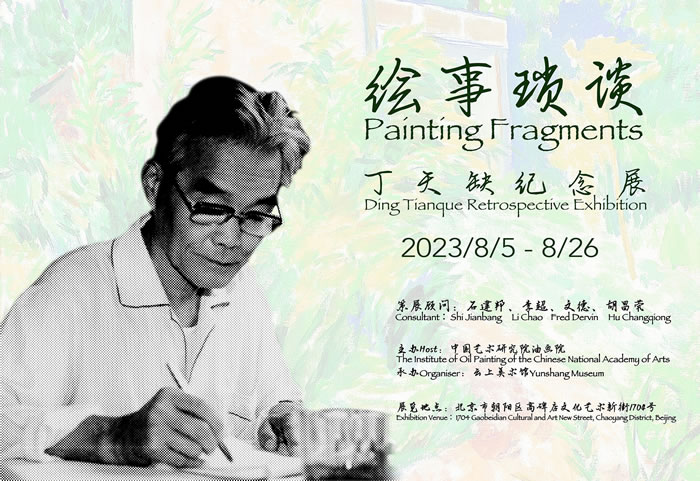
展覽海報(bào)
展覽名稱:“ 繪事瑣談”丁天缺紀(jì)念展
策展顧問(wèn):石建邦、李超、文德、胡昌煢
文獻(xiàn)整理:丁韻秋
開(kāi)幕時(shí)間:2023年8月5日周六下午三點(diǎn)開(kāi)幕(需要邀請(qǐng)函入場(chǎng))
主辦單位:中國(guó)藝術(shù)研究院油畫院
承辦單位:云上美術(shù)館 (北京市朝陽(yáng)區(qū)高碑店文化藝術(shù)新街1704號(hào))
協(xié)辦單位:ICI LABAS 藝棧 、CCIFC中國(guó)法國(guó)商會(huì)、Capella Cultural Program 嘉佩樂(lè)文化計(jì)劃、AFAP法國(guó)造型藝術(shù)家協(xié)會(huì)、WM ARCHITECTS法國(guó)米多建筑設(shè)計(jì)師事務(wù)所
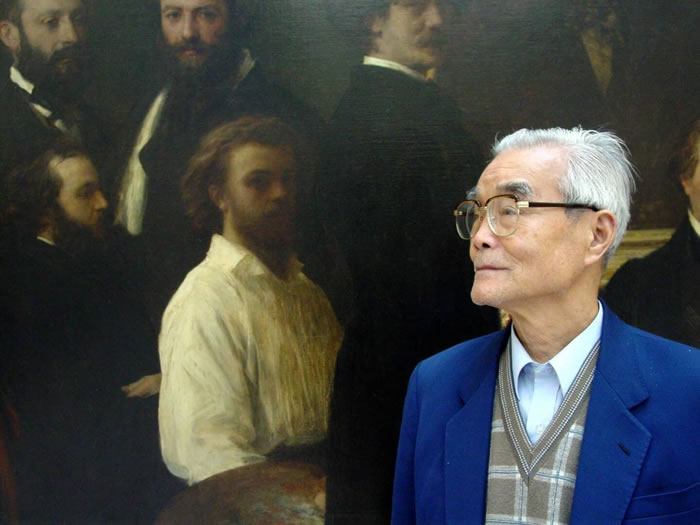
丁天缺先生照片
為天缺公而歌
——丁天缺紀(jì)念展序言
李超
20世紀(jì)的中國(guó)美術(shù)歷史長(zhǎng)河,不乏藝術(shù)群體的星光閃耀。發(fā)端于西湖之畔的國(guó)立藝專的第二代,正是這樣具有核心作用的代表性的藝術(shù)群體。謂其核心,在于中國(guó)的現(xiàn)代美術(shù)教育學(xué)術(shù)主體力量,賦予歷史轉(zhuǎn)型以中國(guó)之魂和東方之韻。以師生傳承作為學(xué)術(shù)基點(diǎn)的第二代,隨同其師,親歷并參與了歷史的轉(zhuǎn)型,見(jiàn)證了學(xué)院“調(diào)和中西藝術(shù),創(chuàng)造時(shí)代藝術(shù)”的學(xué)術(shù)影響力。這種“為藝術(shù)戰(zhàn)”精神氣質(zhì),猶如血脈胎印,注定他們將學(xué)術(shù)抱負(fù)與藝術(shù)責(zé)任,與中國(guó)民族藝術(shù)的振興命運(yùn)相連,這種學(xué)院品格賦予了第二代獨(dú)特的藝術(shù)生命力,這是他們奉獻(xiàn)于20世紀(jì)中國(guó)美術(shù)可歌可泣的精神禮贊。
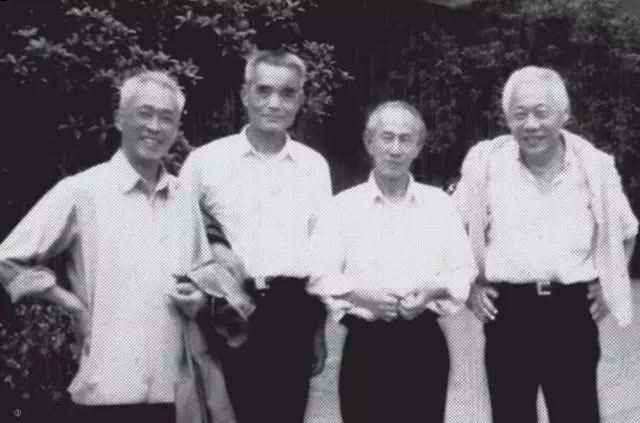
丁天缺(左二)與吳季鑫、莊華岳、趙無(wú)極
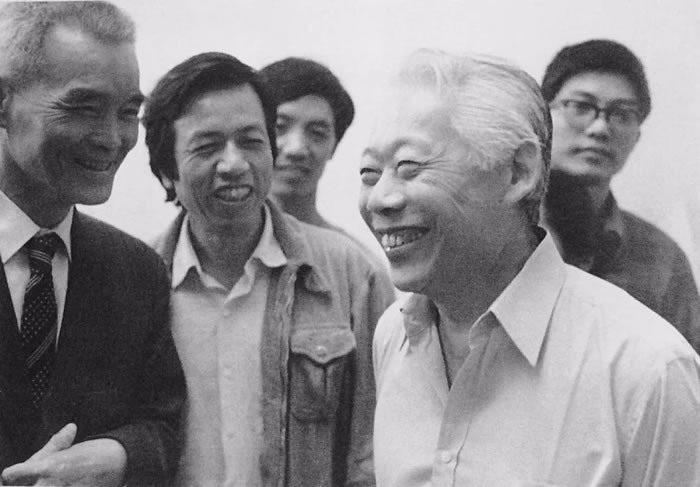
1985年春趙無(wú)極回杭州母校舉辦油畫講學(xué)班時(shí)合影 左起丁天缺、尚揚(yáng)、孫建平、趙無(wú)極、許江
然而,對(duì)于國(guó)立藝專第二代的認(rèn)知,實(shí)質(zhì)上是“遲到”的發(fā)現(xiàn)。其中初始的引發(fā)點(diǎn),是20世紀(jì)80年代本土現(xiàn)代藝術(shù)歷史的關(guān)注。包括趙無(wú)極、朱德群等在內(nèi)的海外軍團(tuán)。隨之對(duì)應(yīng)著那段風(fēng)雨兼程的文脈歷史,逐漸再度認(rèn)知他們的師長(zhǎng)林風(fēng)眠、吳大羽、蔡威廉、方干民等諸多先賢的作為;也逐漸還原著吳冠中、閔希文、張功慤、丁天缺等諸多弟子的史實(shí),他們含帶各自的歷史遮蔽,進(jìn)入我們后學(xué)研究的視野。在還原與認(rèn)知的過(guò)程中,我們不禁感佩他們?cè)谌松哪ルy中不息保存藝術(shù)意志的堅(jiān)韌,感佩他們與世界對(duì)話的藝術(shù)語(yǔ)言的前沿實(shí)驗(yàn)特質(zhì)。其中丁天缺不失為一種特殊的呈現(xiàn)。——不管歷史存有多少曲折與磨難,只要存有覺(jué)醒者所謂“懷有同樣潔愿的人,無(wú)別離”的心智,就有高度和光芒的格局,就有再生和共享的未來(lái)。

杭州美院校慶70周年合影
丁天缺的藝術(shù)人生,是一段淚水與星光交織一體的“傳奇”;更是歷練自強(qiáng)而歷久彌新的中國(guó)現(xiàn)代美術(shù)的“華彩”。而作為第二代的丁公的同窗學(xué)友,他們是相映成輝的命運(yùn)共同體。如今皆為美術(shù)史研究中的一線名家,他們何以共同進(jìn)入歷史研究“勝利者的清單”,難道不正是這樣高度與光芒嗎?
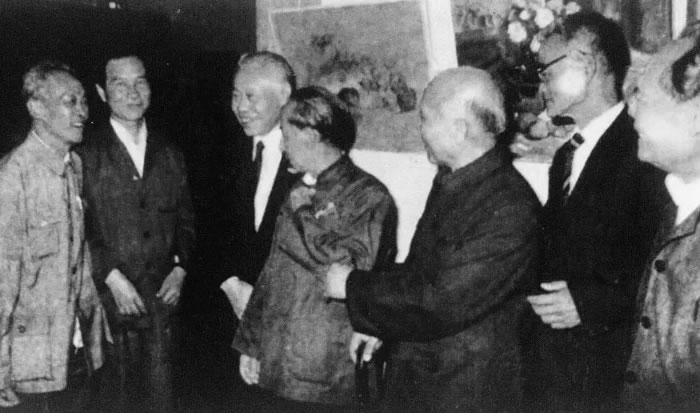
1984年,丁天缺與林文錚、趙無(wú)極、張功慤、胡善馀等
隨著行文的行進(jìn),思緒中涌現(xiàn)出30年來(lái),陸續(xù)與第二代前輩交往的經(jīng)歷,對(duì)于國(guó)立藝專第二代的認(rèn)識(shí),從書本轉(zhuǎn)為現(xiàn)場(chǎng)。90年代初為撰寫《上海油畫史》而專程拜訪閔希文先生。1996年赴京,專程為吳大羽先生舉行的學(xué)術(shù)研討會(huì)發(fā)言學(xué)習(xí)。當(dāng)時(shí)吳冠中、張功慤等第二代出席此會(huì)。他們?yōu)榈谝淮膮谴笥鸲鴣?lái),卻道出了令人感動(dòng)的第二代的情緣。四年前,我有幸見(jiàn)到第二代的最長(zhǎng)壽的見(jiàn)證者張功慤先生。倘若吳大羽是一顆不可忘卻的“星”,那么教學(xué)相長(zhǎng)的相關(guān)師生,已經(jīng)合成為獨(dú)具光彩的“群星”。由此于三年前,完成了“看不見(jiàn)”的國(guó)立藝專第二代的初稿寫作。
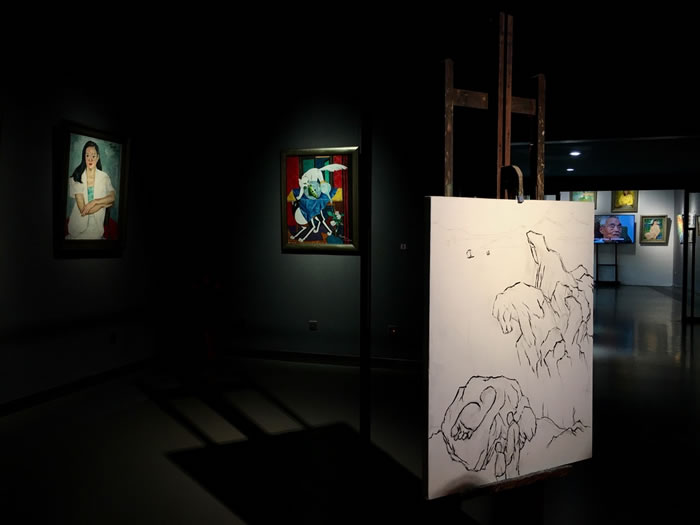
2018年丁天缺個(gè)展,丁老生前所用畫架與未完成的畫
此稿再修訂,自然來(lái)自今年丁韻秋老師以及她的朋友圈的支持與鼓勵(lì)。在我接觸到的三百多位中國(guó)油畫名輩家屬中,不乏擁有特別人文情懷者,丁天缺的侄女丁韻秋女士,即是其中生動(dòng)可敬的一位。通過(guò)她之前組織和努力,加之朋友圈的齊心協(xié)力,2021年成為丁天缺的“蘇醒”時(shí)間。——2021年3月13日,丁天缺回顧展在京開(kāi)幕,這不僅是藝棧畫廊的2021年首展,也是2018年末《夢(mèng)里孤山——丁天缺藝術(shù)人生》由中國(guó)美術(shù)學(xué)院出版社出版,學(xué)界見(jiàn)得丁天缺遺著一書問(wèn)世后在北京的一次重要呈現(xiàn)。2021年10月在杭州國(guó)立藝專舊址,西泠書畫院舉辦《丁天缺詩(shī)詞集》首發(fā)式暨學(xué)術(shù)茶聚。2021年年底。藝棧畫廊迎來(lái)了年末壓軸大展:丁天缺詩(shī)畫展。此次展覽是繼“丁天缺詩(shī)詞集”首發(fā)活動(dòng)后,移至北京的再度亮相。通過(guò)對(duì)丁天缺先生的詩(shī)詞手稿及繪畫原作、版畫的展示,向觀眾呈現(xiàn)其更加生動(dòng)的創(chuàng)作成果。
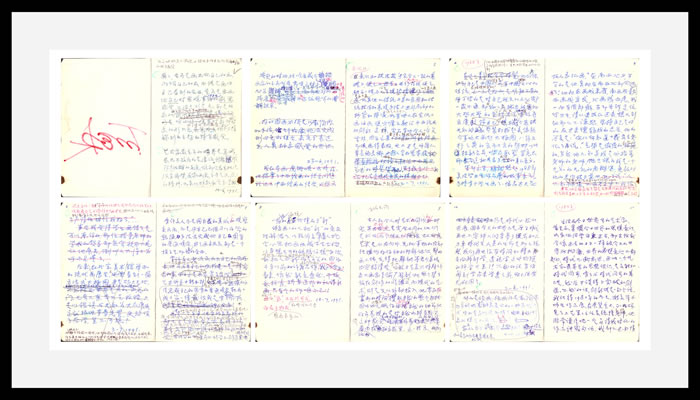
丁天缺部分日記手稿
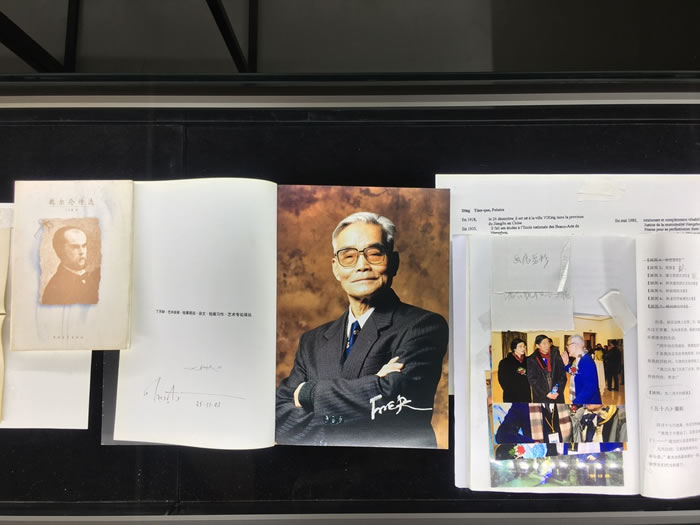
丁天缺部分著作
跨越疫情困頓之期,2023年6月,我與團(tuán)隊(duì)在北京拜訪丁韻秋老師,她又向我們呈現(xiàn)了她與家人共同整理與翻譯的成果,《藝舟夜楫——繪事瑣談》,英文譯本(with original Chinese script),這成為了丁老師與她的友人,在今年策劃相關(guān)丁天缺藝術(shù)巡展的一個(gè)重要學(xué)術(shù)焦點(diǎn)。——2023年,孕育著為丁天缺“再生”而行動(dòng)的高光時(shí)刻。
《夢(mèng)里孤山》、《丁天缺詩(shī)詞集》與“繪事瑣談”手稿,是丁老留給我們后學(xué)的學(xué)術(shù)遺產(chǎn),是這位藝術(shù)先賢留給世界的珍貴藝術(shù)之物與歷史之物,可以視作為國(guó)立藝專第二代的學(xué)術(shù)結(jié)晶,饋贈(zèng)于畫界與學(xué)林。今時(shí),在國(guó)立藝專第二代漸行漸遠(yuǎn)于天國(guó)的同時(shí),先賢的諸多精彩的話語(yǔ)與概念,凝聚其藝術(shù)創(chuàng)作與思想,化作歷史的回響,令我們深味不已。在古今之間,在中西之間,作為藝術(shù)家的文化融合使然,丁老的相關(guān)的筆記,字語(yǔ)真切,呈現(xiàn)了視野的寬度和思考的深度。這是第二代先賢們藝術(shù)思想的又一次折光。
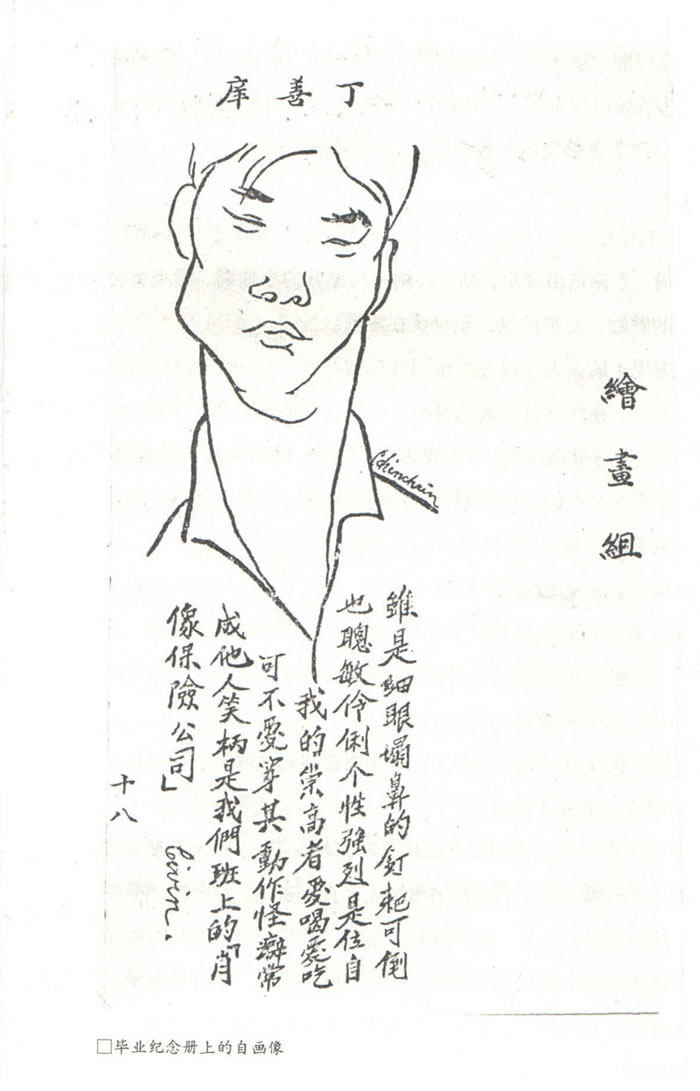
值得關(guān)注的是,第二代的藝術(shù)雖然各自發(fā)展有別,但是學(xué)院派的基因與影響,構(gòu)成了他們藝術(shù)創(chuàng)作中的某些共性的呼應(yīng)關(guān)系。比如時(shí)空結(jié)構(gòu)的概括性、心靈世界的抒情性、中國(guó)意象的書寫性。不過(guò)在第二代的藝術(shù)家之中,他們各自形成自己的藝術(shù)探索的風(fēng)格化路徑。從目前所見(jiàn)的丁天缺的40年代作品圖像而言,對(duì)于形式表現(xiàn)的敏感與創(chuàng)造,已經(jīng)呈現(xiàn)在早年的藝術(shù)實(shí)踐之中,中后期跨越80至90年代,難能可貴地呈現(xiàn)藝術(shù)復(fù)蘇的生命力,所作靜物、肖像和景物,已經(jīng)賦予多種變體與重構(gòu)的探索跡象,相關(guān)藝術(shù)創(chuàng)作在空間構(gòu)成、色彩表現(xiàn)與圖像寓意等方面,體現(xiàn)傳統(tǒng)守正與語(yǔ)言創(chuàng)新的互通與協(xié)調(diào)。再一次驗(yàn)證藝術(shù)創(chuàng)作中“新”的辯證理解與貫通。在傳統(tǒng)深處提取創(chuàng)新探索的新元素,在國(guó)際對(duì)話的語(yǔ)境中彰顯現(xiàn)代藝術(shù)的“中國(guó)時(shí)態(tài)”,——由此賦予丁天缺藝術(shù)的學(xué)術(shù)品格。其畫風(fēng)求新獨(dú)到,個(gè)性率真而別開(kāi)生面,又與第二代的創(chuàng)作面貌相得益彰,成為20世紀(jì)中國(guó)現(xiàn)代繪畫時(shí)代標(biāo)程的生動(dòng)縮影。
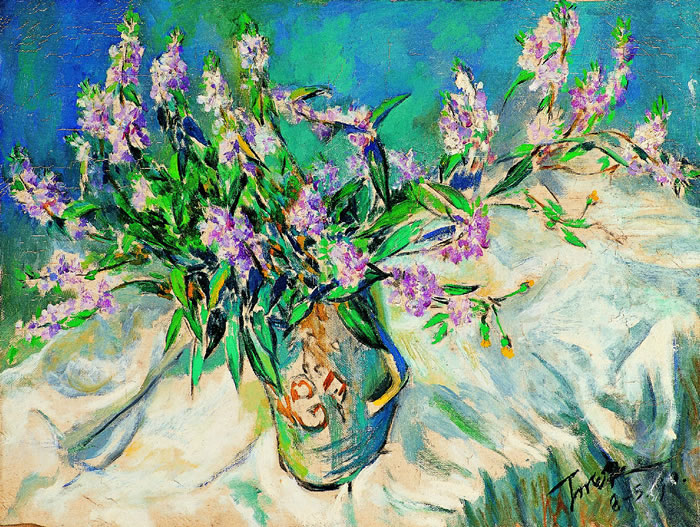
1990 花Flower 61×46cm
文化傳承有如生命紐帶,牽連著兩代藝術(shù)家“為藝術(shù)而戰(zhàn)”的藝術(shù)歷程。這兩代藝術(shù)家群體的研究,其價(jià)值意義,已經(jīng)不限于相關(guān)的校史研究的范疇,而逐漸移入中國(guó)現(xiàn)代美術(shù)歷史研究,乃至中國(guó)近現(xiàn)代美術(shù)國(guó)際交流的專題領(lǐng)域。2023年的丁天缺紀(jì)念展,無(wú)疑形成了可觀的學(xué)術(shù)拓展。而其中一個(gè)潛在的學(xué)術(shù)訴求,即為“丁天缺與他的時(shí)代”。這樣的學(xué)術(shù)定位,賦予了丁天缺與第二代藝術(shù)資源的共生與兼容,構(gòu)建了從本土出發(fā),向世界述說(shuō)中國(guó)故事的敘事語(yǔ)境。
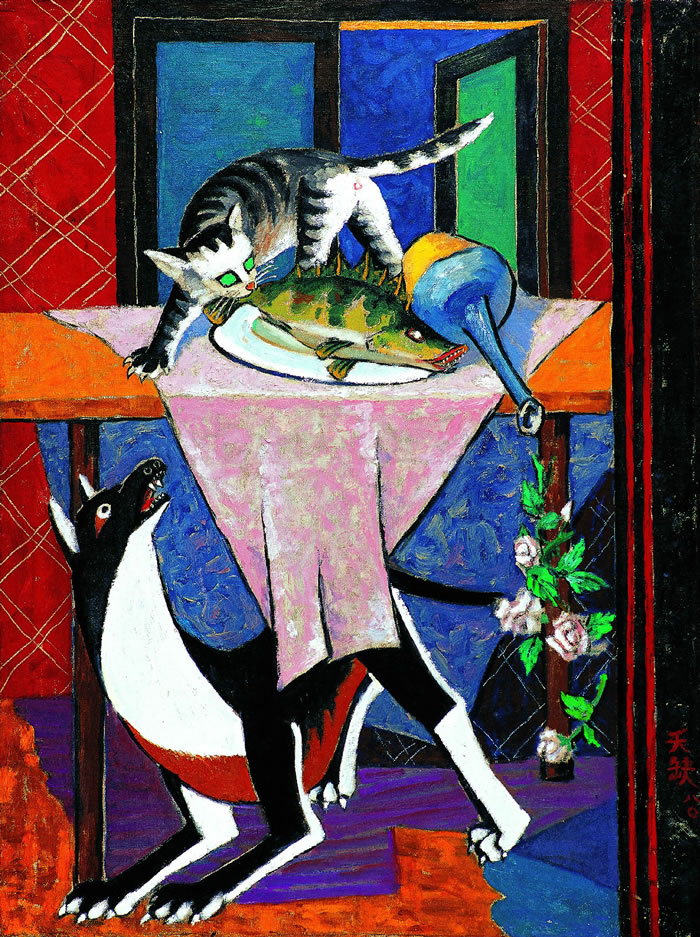
1980窗前偶見(jiàn)80x73cm
與展覽的策劃團(tuán)隊(duì)相約同行,我們有所感悟的是,一個(gè)閃光的點(diǎn),帶動(dòng)著華彩的線。由丁公天缺先賢引至國(guó)立藝專第二代先賢們,這樣的藝術(shù)群體進(jìn)入藝術(shù)史的研究對(duì)象,其相關(guān)的歷史之物與藝術(shù)之物的復(fù)合,是研究得到持續(xù)而深入的重要關(guān)鍵。在這里,一代與二代皆有被遮蔽與碎片之殘存境遇,相關(guān)藝術(shù)遺產(chǎn)的存世量或多或少,相關(guān)藝術(shù)文獻(xiàn)著錄率或重或稀,我們也十分愿意通過(guò)自己的學(xué)術(shù)積累與數(shù)據(jù)庫(kù)的加持,體現(xiàn)近現(xiàn)代美術(shù)研究成果學(xué)術(shù)賦能的作用。由此可見(jiàn),此次紀(jì)念展的巡展歷程,將是一個(gè)學(xué)術(shù)與合作、互動(dòng)、共享的社會(huì)美育的生動(dòng)范例。經(jīng)歷20世紀(jì)80年代至今,國(guó)立藝專藝術(shù)家逐漸涌現(xiàn),迄今形成中國(guó)近現(xiàn)代藝術(shù)史研究視野中,不可或缺的重要藝術(shù)群體。幾乎每一個(gè)生動(dòng)的個(gè)體,都牽動(dòng)著這一藝術(shù)群體珍貴的文化資源。今天,丁天缺紀(jì)念展再次顯現(xiàn)應(yīng)有的學(xué)術(shù)之光。
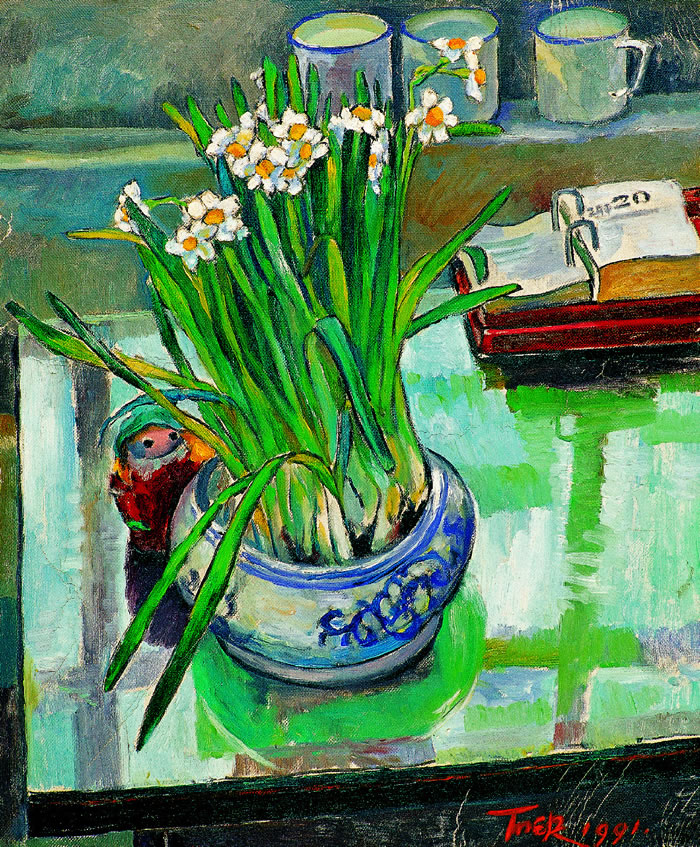
1991歲朝58x48cm
為天缺公而歌,——是為國(guó)美二代“無(wú)別離”而念的初衷;是對(duì)丁天缺藝術(shù)資源“再生”的期待;更是為優(yōu)化中國(guó)近現(xiàn)代藝術(shù)史研究學(xué)術(shù)生態(tài)的獻(xiàn)力。
2023年7月于千蕖堂

丁先生坐在畫前
Ding Tianque Retrospective Exhibition“Painting Fragments”2023/8/5 - 8/26
Consultant:Shi Jianbang Li Chao Fred Dervin Hu Changqiong
Documents arrange:Ding Yunqiu
Opening: Saturday 05/08/2023 at 3:00 p.m.
Host:The Institute of Oil Painting of the Chinese National Academy of Arts
Organiser:Yunshang Museum(Gaobeidian Cultural and Art New Street, Chaoyang District, Beijing)
Co-Organizer:ICI LABAS 藝棧 、CCIFC中國(guó)法國(guó)商會(huì)、Capella Cultural Program 嘉佩樂(lè)文化計(jì)劃、AFAP法國(guó)造型藝術(shù)家協(xié)會(huì)、WM ARCHITECTS法國(guó)米多建筑設(shè)計(jì)師事務(wù)所
Praise for Ding Tianque
Introduction to the Retrospective Exhibition
Li Chao
(Translation: Prof. Dr. Dervin, University of Helsinki, Finland)
The history of 20th century Chinese art is wide-ranging and has produced a long list of important figures and art groups. Amongst them, the Second Generation of the National Art College, which originated on the shores of the West Lake in Hangzhou, played a significant role. The group contributed academically to China’s modern art education, transforming in the process the soul of China and the charm of the East. The Second Generation, which built upon predecessors and peers, has experienced and participated in the transformation of history through its teachers, witnessing the academic influence of the school in “reconciling Chinese and Western art and creating art of the times”. The spirit of ‘fighting for art’, like a bloodline birthmark, destined them to link their academic ambition and artistic responsibility with the revitalization of Chinese national art. This academic character endowed the Second Generation with unique artistic vitality, which corresponded to their spiritual tribute to the singing and weeping of Chinese art in the 20th century.

1999人生92x73cm
The significance of the Second Generation of the National Art College was in fact a ‘late’ discovery. The initial trigger started in local modern art history of the 1980s with the recognition of Chinese artists who were based overseas such as Zao Wou-ki and Chu Teh-Chun. Subsequently, many other artists came to be recognized as prominent artistic figures such as Lin Fengmian, Wu Dayu, and Fang Ganmin. Gradually other long forgotten artists, amongst whom Wu Guanzhong, Min Xiwen, Zhang Gongyi, Ding Tianque and many other disciples, were also rediscovered. In the process of restoration and cognition, we can’t help but admire their tenacity in preserving their artistic will in the tribulations of life, and admire the cutting-edge experimental characteristics of their artistic language in dialogue with the world. Amongst these major figures of Chinese 20th century art, Ding Tianque plays a special role. No matter how many trials and tribulations history witnesses, as long as there is a so-called mentality of “same aspirations, no separation”, there will be a pattern of height and light, and there will be a future for regeneration and bonding.
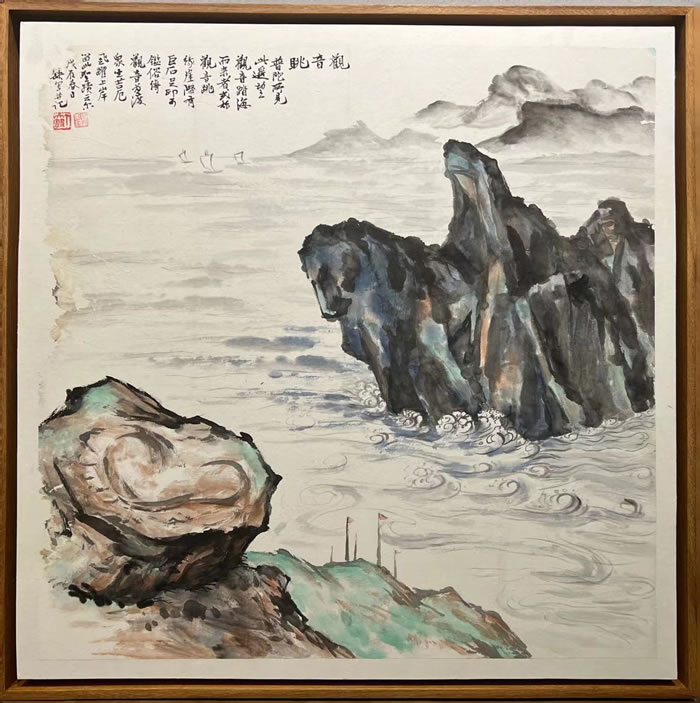
國(guó)畫觀音眺
Ding Tianque’s artistic life is ‘legendary’, intertwined with tears and moments of hope. His life also symbolizes the ‘brilliance’ of modern Chinese art that experienced self-improvement. It was also a long-lasting life. Together with his classmates from the Second Generation, Ding formed a community of shared destiny. Now that they are all prominent masters in art history research, why did they all enter the ‘list of prizewinners’ in historical research?
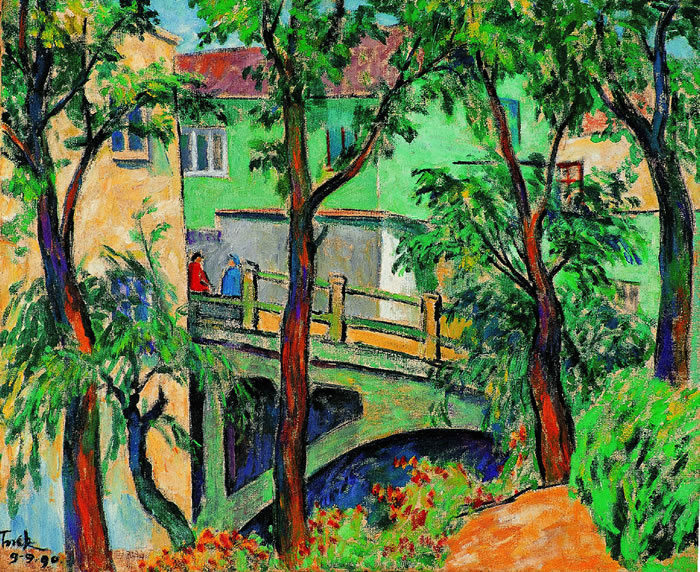
1990聽(tīng)蟬61x50cm
As a scholar specializing in the Second Generation, I had the opportunity to interact with some of its senior members over the past 30 years. In the early 90s, I visited Mr. Min Xiwen in order to write about the ‘History of Shanghai Oil Painting’. In 1996, I spoke at an academic seminar held by Mr. Wu Dayu in Beijing. Wu Guanzhong, Zhang Gongyi and other members of the Second Generation attended the seminar. They came for the First Generation of Wu Dayu, but their words about their Second Generation were touching. Four years ago, I also had the privilege of meeting personally Mr. Zhang Gongyi, the oldest witness of the Second Generation. If Wu Dayu is a ‘star’ that cannot be forgotten, then the relevant teachers and students who have learnt from his teaching have been synthesized into a unique ‘star’. Three years ago, I completed my first draft about the Second Generation of the ‘Invisible’ National Art College.
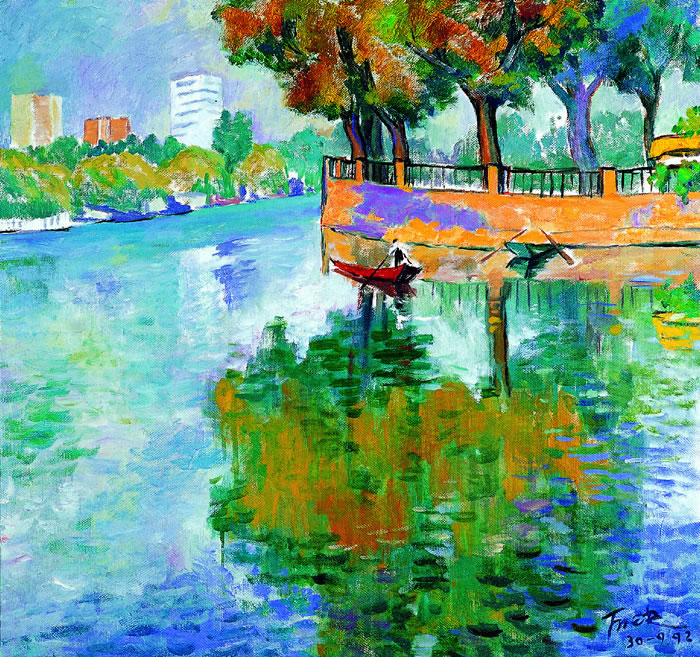
1992什剎海61x50cm
The draft was revised based on the support and encouragement of Ding Yunqiu and her circle of friends. Among the more than 300 family members of famous Chinese oil painters I have come into contact with, many have special humanistic feelings, and Ding Tianque’s dynamic and respectable niece, Ms. Ding Yunqiu, is one of them. Through her remarkable efforts, coupled with the concerted endeavours of her circle of friends, 2021 marked Ding Tianque’s ‘a(chǎn)wakening’ time. On March 13 2021, a retrospective exhibition of Ding Tianque opened in Beijing, which was not only the first exhibition of ICI-LABAS Gallery in 2021, but also an important event in Beijing after the publication of Lonely Mountain in Dreams - Ding Tianque’s Artistic Life by China Academy of Art Press at the end of 2018. In October 2021, the opening ceremony and academic gathering around Ding Tianque’s Poetry Collection was held at the former site of Hangzhou National Art College, Xiling Calligraphy and Painting Institute. At the end of 2021 ICI-LABAS Gallery put together an exhibition of Ding Tianque’s poetry and painting. This was the second time that the Ding Tianque Poetry Collection went on show. Through the display of Mr. Ding Tianque’s manuscripts of poetry, original paintings and prints, the audience could witness his vivid creativity.
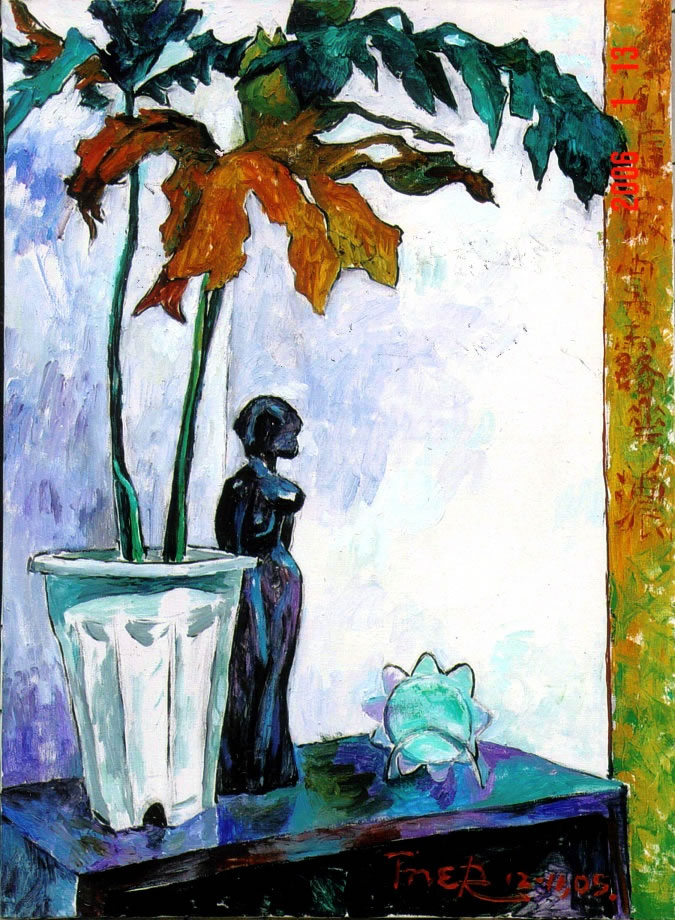
2006閑庭寂寞露華濃 80×60
After overcoming the difficult period of the epidemic, my team and I visited Ding Yunqiu in Beijing in June 2023. During our visit, Ding Yunqiu presented to us a book about Tianque Ding that her family and herself compiled and translated. This book represents an important academic milestone for Ding Tianque’s work. Together with her friends Ding Yunqiu is currently preparing an art tour exhibition of Ding Tianque. 2023 will mark an important year for Ding Tianque’s ‘rejuvenation’.
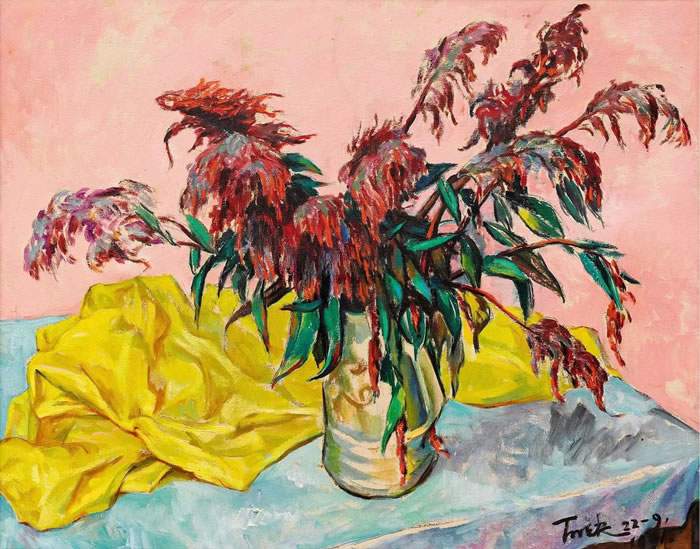
雞冠花 81x64cm
The manuscripts of Lonely Mountain in Dreams, Ding Tianque’s Poetry Collection and Trivia on Pictorial Matters represent an important academic heritage left by Mister Ding for future research. They symbolize precious artistic and historical objects offered to the world by this artistic sage, which can be regarded as mature academic expressions of the Second Generation of the National Art College. Today, while the Second Generation is gradually moving away from the Kingdom of Heaven, many wonderful words and concepts condense their artistic creations and thoughts, and turn them into gratifying echoes of history. Between ancient and modern, between China and the West, as a result of the interculturalisation of art, Ding’s notes present us with his broad vision and deep thinking – evidencing again the artistic philosophy of the sages from the Second Generation.
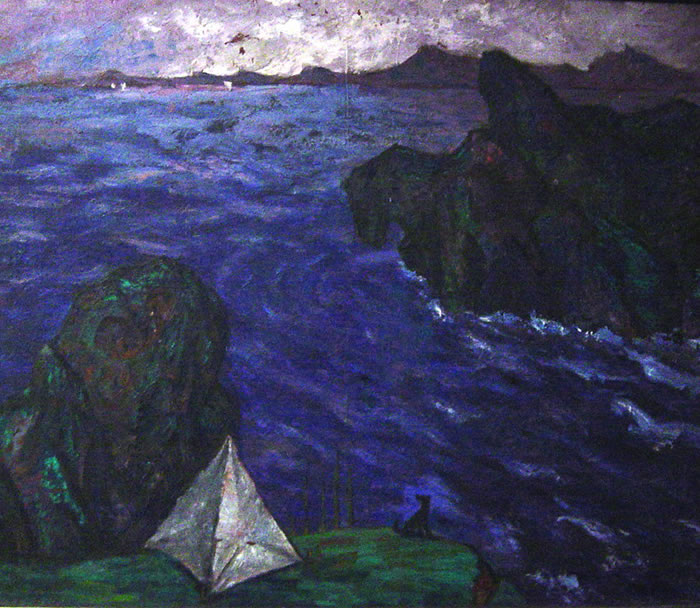
1980觀音跳夕照80x70cm
It is worth noting that, although the art of the Second Generation has developed in different directions, the roots and influences of the academic school constitute common echoes in their artistic creations. These include the generalization of the structure of time and space, the lyricism of the spiritual world, and the writing of Chinese imagery. However, among the artists from the Second Generation, each of them shaped and explored their own stylized artistic path. From the images that we have left of Ding Tianque’s works from the 1940s, but also his art spanning the 1980s and 1990s, the sensitivity and creation of formal expression were always present in his artistic practice. The still-lives, portraits and landscapes that Ding provide a variety of signs of exploration, variation and reconstruction. The related artistic creations reflect the intercommunication and coordination of traditional integrity and language innovation in terms of spatial composition, color expression and image meaning-making. Once again, this evidences the dialectical understanding and penetration of the ‘new’ into artistic creation, extracting novel elements of innovative exploration from the depths of tradition, highlighting the ‘Chinese tense’ of modern art in the context of international dialogue, thus endowing Ding Tianque’s artistic and academic character. His painting style is innovative and unique, and his personality frank and original, which complements well the creativity of the Second Generation. With these, Ding became a vivid epitome of the era of modern Chinese painting in the 20th century.
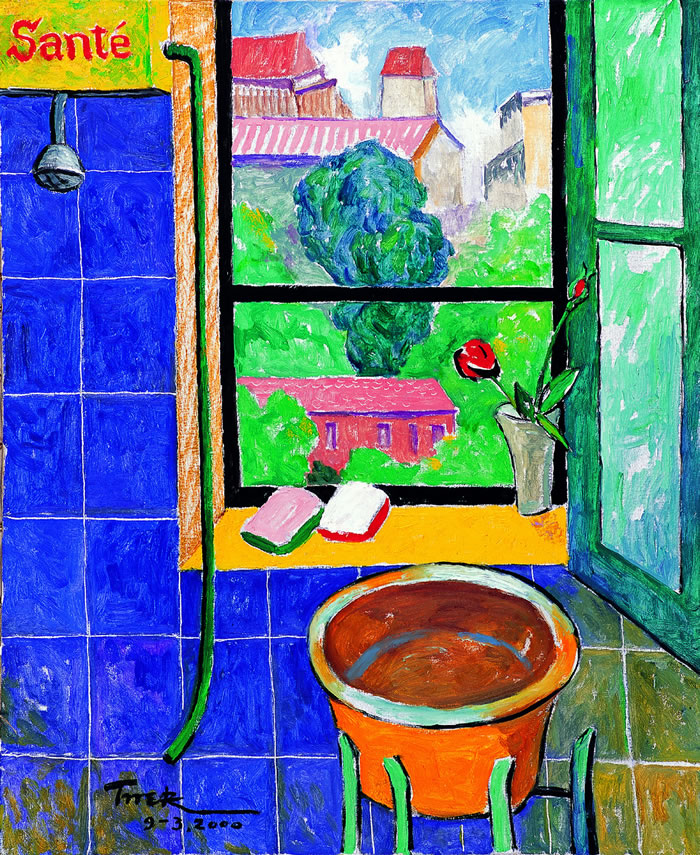
2000盥洗室85x60cm
Cultural inheritance is like a life bond, implicating the artistic journey of two generations of artists who ‘fought for art’. The value and significance of the research on these two generations of artists are not limited to the scope of history research on specific schools, but they have gradually moved into research on the history of modern Chinese art, and even the special field of international exchanges about modern art. The Ding Tianque Retrospective Exhibition of 2023 is undoubtedly contributing to move such academic interests forward. This academic positioning endows Ding Tianque with symbiosis and compatibility with Second Generation art resources, and constructs a narrative that starts from China and tells Chinese stories globally.
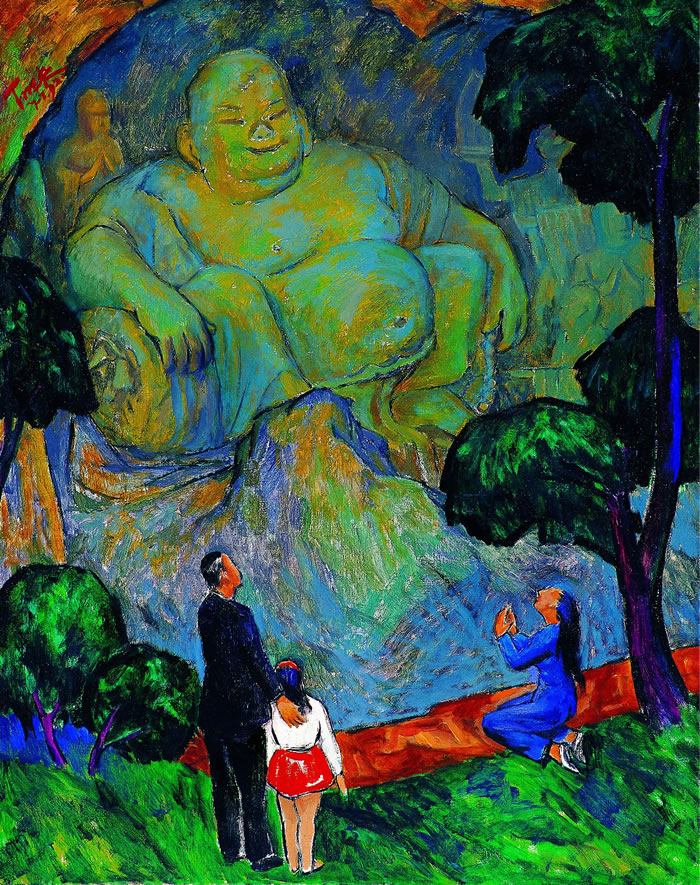
1992皆大歡喜92x73cm
Cooperating with the exhibition planning team, we realized that a shining point drives the line of brilliance. The sages of the Second Generation of the National Art College now represent an important research object in art history, and the combination of related historical and artistic objects is an important key to continuous and in-depth research. Here, the First and Second Generations have the residual situation of being obscured and fragmented; the existence of relevant artistic heritage can be limited; the bibliographic rate of relevant art documents is heavy or rare. We are also enthusiastic about reflecting on the role of academic empowerment of the achievements of modern art research through our own academic and database collections. It can be seen that the tour of this retrospective exhibition will be a vivid example of academic cooperation, interaction and social aesthetic education. From the 1980s to the present, artists from the National Art College have gradually emerged, forming an indispensable and important art group in research on modern Chinese art history. Almost every vibrant individual showcases precious cultural resources of this artistic group. Today, the Ding Tianque Retrospective Exhibition once again shines the academic light it deserves.
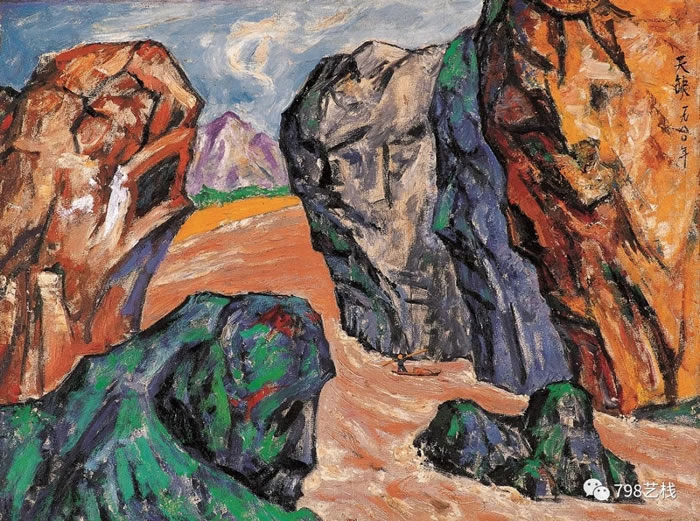
《虎跳峽》1980-85x64cm
Praise for Tianque Ding – the original intention of the Second Generation was to ‘leave nothing’. The ‘regeneration’ of Ding Tianque’s artistic resources definitely contributes to optimizing the academic ecology of modern Chinese art history research.
Senjodo, July 2023




